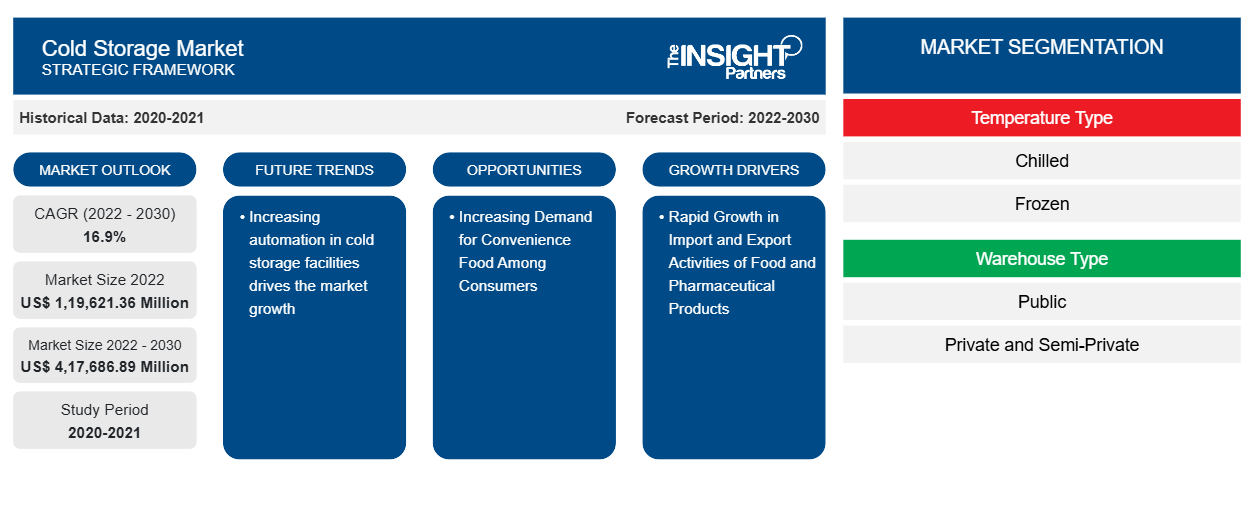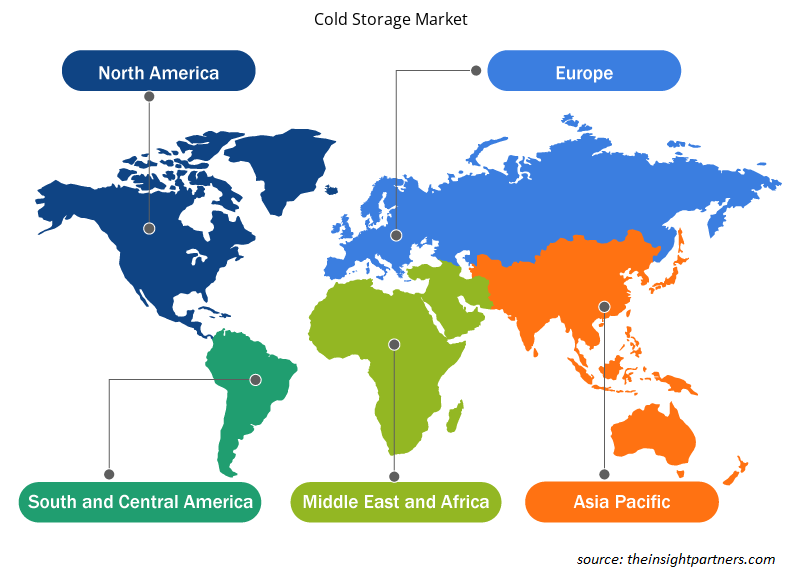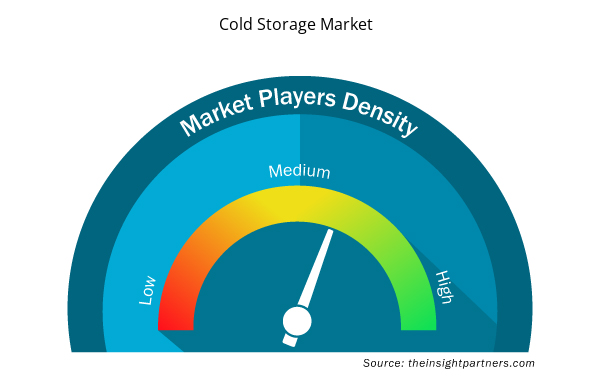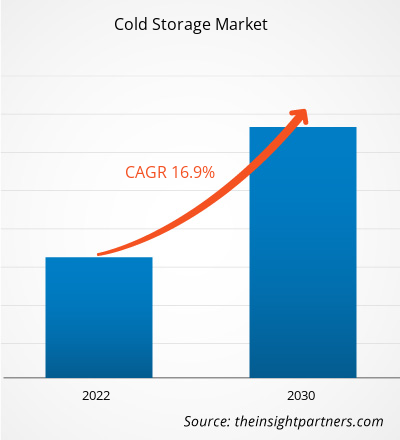Cold storage market size is projected to reach US$ 4,17,686.89 million by 2030 from US$ 1,19,621.36 million in 2022. The market is expected to register a CAGR of 16.9% in 2022–2030.
The rising consumer preference for processed and easy-to-cook canned food boosts the demand for cold storage facilities. In addition, the growing adoption of omnichannel grocery shopping and the proliferation of online shopping are also benefitting the cold storage market globally. Consumers are considering online shopping for groceries as it is safe and helps save time. The booming food & beverages sector, due to growing demand for canned and frozen food products, along with development in the pharmaceutical sector, is also propelling the global cold storage market
Cold Storage Market Analysis
Growing population, rising urbanization, increasing disposable income, and rising busy lifestyle are driving the demand for processed, canned, and easy-to-make food items globally. The canned or convenience food items require proper storage facilities to be in consumable condition. The importance of cold storage facilities is undeniable, as processed foods have a high chance of getting rotten within a few days or weeks if not preserved well. The maintained optimal temperature and proper storage conditions are essential for extending the shelf life of processed or canned food.
Cold Storage Market Overview
Cold storage is an exclusive storage facility used to store temperature-sensitive goods or products, often perishable items, including frozen foods, fresh produce, and pharmaceutical products. Cold storage facilities help to ensure the integrity, freshness, and safety of perishable products. Fruits, vegetables, seafood, fish, Middle East and Africa, processed food, and pharmaceutical product producers transport their items for further processing and labelling. After harvesting crops or slaughtering chicken, beef, and pork, the raw crops and Middle East and Africa-based products are transported to processing hubs for packaging.
Customize This Report To Suit Your Requirement
You will get customization on any report - free of charge - including parts of this report, or country-level analysis, Excel Data pack, as well as avail great offers and discounts for start-ups & universities
Cold Storage Market: Strategic Insights

- Get Top Key Market Trends of this report.This FREE sample will include data analysis, ranging from market trends to estimates and forecasts.
Customize This Report To Suit Your Requirement
You will get customization on any report - free of charge - including parts of this report, or country-level analysis, Excel Data pack, as well as avail great offers and discounts for start-ups & universities
Cold Storage Market: Strategic Insights

- Get Top Key Market Trends of this report.This FREE sample will include data analysis, ranging from market trends to estimates and forecasts.
Cold Storage Market Drivers and Opportunities
Rising Demand for Cold Storage in the Pharmaceutical Industry Drives the Market Growth
Several countries across the globe are implementing strict rules and regulations to manufacture and store the pharmaceutical products. Cold storage is important in the pharmaceutical industry to ensure the efficacy, safety, and integrity of various vaccines and drugs. These drugs are required to maintain at specific temperature during storage. Hence, cold storage facilities are used to preserve the quality and the potency of pharmaceutical products. According to the World Health Organization (WHO) and the Indian Pharmaceutical Association (IPA) have provided certain standard guidelines and rules for the storage and dispensing of the pharmaceutical medicines.
Increasing Demand for Convenience Food Among Consumers
Growing population, rising urbanization, increasing disposable income, and rising busy lifestyle are driving the demand for processed, canned, and easy-to-make food items globally. The canned or convenience food items require proper storage facilities to be in consumable condition. The importance of cold storage facilities is undeniable, as processed foods have a high chance of getting rotten within a few days or weeks if not preserved well. The maintained optimal temperature and proper storage conditions are essential for extending the shelf life of processed or canned food. Over the years, consumers' lifestyles have evolved drastically; and the growing number of working populations are some of the major driving factors for the cold storage market. In addition, increased marketing exposure of processed food is also attracting major younger generation toward consuming processed food. The rise in demand for canned and processed food is boosting the requirement for cold storage facilities globally. For instance, the share of processed food exports in agri-exports increased significantly from 13.7% in 2014–2015 to 25.6% in 2022–2023 in India. The US also showed a high consumption rate of processed or canned food as those are tasty, time-saving, and convenient products.
Cold Storage Market Report Segmentation Analysis
Key segments that contributed to the derivation of the cold storage market analysis are temperature type, warehouse type, and application.
- Based on temperature type, the market is divided into chilled, and frozen.
- Based on temperature type, the global cold storage market is bifurcated into chilled and frozen. Chilled storage facilities primarily cater to preserving dairy products such as milk, fresh cream, curd, milk-based beverages, cheese, processed cream, and medicines (including tablets). On the other hand, frozen storage facilities help preserve frozen meat, processed food, fish, seafood, chemicals, and pharmaceutical products—such as vaccines.
- Based on warehouse type, the global cold storage market is classified into public, private, and semi-private. The growing demand for seasonal fruits, vegetables, and processed food products is driving the demand for cold storage facilities.
- Based on application, the cold storage market is categorized into dairy, fish, meat and seafood, fruits and vegetables, pharmaceuticals, and processed food. The rise in inclination toward processed food and the busy lifestyle of consumers are boosting the requirement for convenient food products that possess longer shelf life, further creating the demand for cold storage facilities.
Cold Storage Market Share Analysis by Geography
The geographic scope of the cold storage market report is mainly divided into five regions: North America, Asia Pacific, Europe, Middle East & Africa, and South America.
Asia Pacific is expected to grow with highest CAGR during the forecast period. This is primarily owing to growing population, increasing per capita income, and rising consumer inclination toward consuming frozen and processed food products. The demand for cold storage facilities is higher in several Asia Pacific countries such as China, India, South Korea, Japan, and Australia.
The growing popularity of online grocery sales and e-commerce platforms, which were further augmented by the pandemic and social distancing, majorly contribute to the market growth. Furthermore, the growing government initiatives to implement schemes and policies that support vigorous import and export of products are boosting the growth of the cold storage market in Asia Pacific.
Cold Storage Market Regional Insights
The regional trends and factors influencing the Cold Storage Market throughout the forecast period have been thoroughly explained by the analysts at Insight Partners. This section also discusses Cold Storage Market segments and geography across North America, Europe, Asia Pacific, Middle East and Africa, and South and Central America.

- Get the Regional Specific Data for Cold Storage Market
Cold Storage Market Report Scope
| Report Attribute | Details |
|---|---|
| Market size in 2022 | US$ 1,19,621.36 Million |
| Market Size by 2030 | US$ 4,17,686.89 Million |
| Global CAGR (2022 - 2030) | 16.9% |
| Historical Data | 2020-2021 |
| Forecast period | 2022-2030 |
| Segments Covered |
By Temperature Type
|
| Regions and Countries Covered | North America
|
| Market leaders and key company profiles |
Cold Storage Market Players Density: Understanding Its Impact on Business Dynamics
The Cold Storage Market market is growing rapidly, driven by increasing end-user demand due to factors such as evolving consumer preferences, technological advancements, and greater awareness of the product's benefits. As demand rises, businesses are expanding their offerings, innovating to meet consumer needs, and capitalizing on emerging trends, which further fuels market growth.
Market players density refers to the distribution of firms or companies operating within a particular market or industry. It indicates how many competitors (market players) are present in a given market space relative to its size or total market value.
Major Companies operating in the Cold Storage Market are:
- Constellation Cold Logistics Sarl
- Nafta Frigorificos Sa De Cv
- Superfrio Armazens Gerais SA
- Tippmann Group
- Nichirei Corp
- Frialsa Frigorificos Sa De Cv
Disclaimer: The companies listed above are not ranked in any particular order.

- Get the Cold Storage Market top key players overview
Cold Storage Market News and Recent Developments
The cold storage market is evaluated by gathering qualitative and quantitative data post primary and secondary research, which includes important corporate publications, association data, and databases. The following is a list of developments in the market for innovations, business expansion, and strategies:
- In April 2024, BOOTES, first Net-Zero company, and CargoPeople, India-based multi-modal Logistics company made joint venture to launch Net-Zero energy cold storage facility to address the demand for critical food and beverage wastage challenge in India. (Source: Eurofins, Press Release)
Cold Storage Market Report Coverage and Deliverables
The “Cold Storage Market Size and Forecast (2020–2030)” report provides a detailed analysis of the market covering the following areas:
- Cold Storage Market size and forecast at global, regional, and country levels for all the key market segments covered under the scope
- Market dynamics such as drivers, restraints, and key opportunities
- Cold Storage Market Trends
- Detailed PEST Analysis and SWOT analysis
- Cold Storage Market Analysis covering key market trends, Global and regional framework, major players, regulations, and recent market developments.
- Cold Storage Market Industry landscape and competition analysis covering market concentration, heat map analysis, prominent players, and recent developments.
- Detailed Company Profiles
- Historical Analysis (2 Years), Base Year, Forecast (7 Years) with CAGR
- PEST and SWOT Analysis
- Market Size Value / Volume - Global, Regional, Country
- Industry and Competitive Landscape
- Excel Dataset



Report Coverage
Revenue forecast, Company Analysis, Industry landscape, Growth factors, and Trends

Segment Covered
Temperature Type, Warehouse Type, and Application

Regional Scope
North America, Europe, Asia Pacific, Middle East & Africa, South & Central America

Country Scope
This text is related
to country scope.
Frequently Asked Questions
Cold storage market size is projected to reach US$ 4,89,529.03 million by 2031.
Increasing automation in cold storage facilities drives the market growth.
Constellation Cold Logistics Sarl, Nafta Frigorificos Sa De Cv, Superfrio Armazens Gerais SA, Tippmann Group, Nichirei Corp, Frialsa Frigorificos Sa De Cv, Friozem Armazens Frigoreticos Ltda, Emergent Cold Latam Management LLC, Americold Realty Trust Inc, Lineage Logistics Holdings LLC, Burris Logistics Co, Chiltern Cold Storage Group Ltd, United States Cold Storage Inc, and Newcold Cooperatief UA and Others.
Rapid growth in import and export activities of food and pharmaceutical products.
North America is expected to dominate the cold storage market in 2023.
The market is expected to register a CAGR of 17.3% in 2023–2031.

 Get Free Sample For
Get Free Sample For